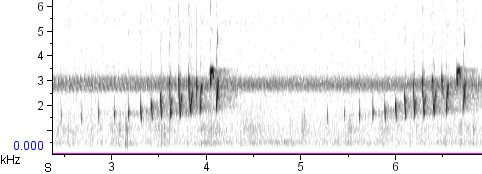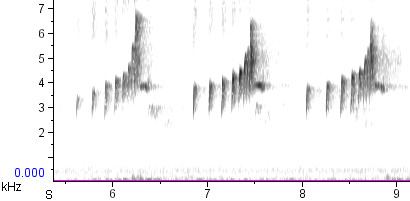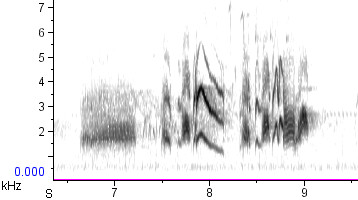You Misidentified It Wrong

The Buff-collared Nightjar is a little-known but highly-sought bird from Mexico that can be found in some of the remote canyons of southernmost Arizona. Seeking this nocturnal rarity can feel like a real adventure. On your way to look for it, you’re guaranteed to pass a sign warning you of terrible dangers, intended to dissuade you from wandering around in the lawless border country lest you meet humanity’s worst elements alone in a dark arroyo.
But the dark arroyos of this remote wilderness are precisely where you must venture if you want to hear the remarkable song of the Buff-collared Nightjar, an evocative rising, bubbly, knocking series that some in Mexico transliterate as préstame tu cuchillo, “lend me your knife” — one of the phrases birders most want to hear from any bird (and, presumably, one of the last phrases they want to hear from a shadowy human figure lurking in the dark thornscrub).
The song of the Buff-collar is so unique that it would seem impossible to mistake for any other bird. But in fact, in the predawn darkness in the very same canyons where the nightjar lives, a strikingly similar sound is often heard from a different bird — a flycatcher that begins its dawn song long before most birders expect day birds to be singing. Over the years, many reports of singing Buff-collared Nightjars have turned out to be flycatchers instead.
According to the classic 1964 publication Birds of Arizona by Phillips, Marshall, & Monson, the source of the nightjar-like dawn song is none other than Cassin’s Kingbird. And this assertion has been repeated by many subsequent credible sources, including Joe Morlan, Kenn Kaufmann (in both North American Birds and in Kingbird Highway), the Arizona Bird Records Committee, the BNA account of Cassin’s Kingbird, and even the Sibley Guide to Birds.
The only problem is, Phillips et al. were mistaken. The dawn song of Cassin’s Kingbird sounds nothing like a Buff-collared Nightjar. It’s the dawn song of Vermilion Flycatcher that causes the confusion. To wit:

(click here for audio)


(click here for audio)
You can see the resemblance between the first two songs on the spectrogram. Of course there are differences: Vermilion Flycatcher’s dawn song is faster and higher-pitched than Buff-collared Nightjar’s song, with a different tone quality. But the similarity in overall pattern is quite striking.
If you’re having difficulty seeing the similarity between Cassin’s Kingbird dawn song and the first two, that’s because it’s completely different. The spectrogram looks nothing like the others, and the song doesn’t sound anything like the others either. And as far as I can tell, nothing else in Cassin’s repertoire comes any closer to resembling the nightjar. However it happened, it looks to me like Phillips et al. named the wrong bird as the confusion species for Buff-collared Nightjar, and most other authors have followed suit for 45 years.
9 thoughts on “You Misidentified It Wrong”
This post inspires me to practice incorrectly misidentifying birds even more!
Great stuff, Nathan- keep it up!
Fantastic work again, Nathan–thank you!
I’d always thought that the real culprit in these cases was Western Kingbird, whose dawn (or pre-dawn) song chip-cha-chip-cha-CHIPadipdip has an obvious rhythmic similarity to the song of the nightjar. Hadn’t even though of Vermilion Flycatcher.
All the best,
rick
That’s funny – I have also noticed that Vermilion Flycatcher’s wind-up song sounds much like Buff-collared Nightjar; in fact, I point it out to everyone I take into Oro Blanco when seeking the Nightjar, and I’ve mentioned it to a lot of folks when listening to Vermilion Flycatchers elsewhere. But I had absolutely no idea that Cassin’s Kingbird had been perpetuated as the confusing culprit, and by so many esteemed sources! Your side-by-side recordings of the two will probably help a lot of birders. Thanks for the fascinating insight. 🙂
Another recording that would be interesting to obtain/analyze would be the Northern Mockingbird in Oro Blanco that imitates the Nightjar. (I imagine other Mockers in Mexico do the same.) To my ear they seem to be a very good mimic of the vocalization, but I wonder how close it actually is?
Cheers,
John Yerger
John,
I haven’t heard that particular mockingbird, although the Buff-collared and Vermilion recordings above came from Oro Blanco Mine itself, and the Cassin’s was recorded a short distance away in California Gulch. In my experience, mockingbirds do a very good job of mimicking other birds. On his blog, Paul Driver has posted an interesting comparison of Northern Mockingbird imitations with spectrograms of the real thing. Check it out.
Hi Nathan, First, thanks for a really excellent and informative blog, I’ve been checking in regularly since you started, and just saw this post. You may be right that some reports of Buff-collared Nightjar are based on Vermilion Flycatcher song instead, but I do hear some similarities between Cassin’s Kingbird and Buff-collared Nightjar songs, and I’d like to offer a few points in defense of those of us who mention Cassin’s Kingbird as a source of confusion. My own story happened back in the dark ages of the early 1980s, when sound recordings of many calls and songs simply weren’t available and none were easily portable, and when there were only a few records of Buff-collared Nightjar in the US.
Like many birders I went to Guadalupe Canyon on one of my first trips to Arizona hoping for the remote possibility of hearing a Buff-collared Nightjar. In the predawn dark as the first birds began to sing I heard this exotic, bubbling, rhythmic song, rising in pitch to an emphatic ending that I could easily fit to the word “cuchillo”. I spent several minutes following the sound and finally got a glimpse of a Kingbird silhouetted against the faint glow of the sky. The combination of lack of familiarity with what Buff-collared Nightjar really sounded like, the desire to hear one, and the presence of an unfamiliar sound that more or less fit the description all combined to make a very real identification pitfall.
To me Western Kingbird, and especially Vermilion Flycatcher, have a sharp sputtering sound that is distinctly flycatcher-like and un-nightjar-like. I heard lots of them and was never confused, but the richer and more varied sounds of Cassin’s Kingbird were not so easily placed. Listening to the recordings at leisure and studying sonagrams it’s clear that Cassin’s Kingbird and Buff-collared Nightjar songs are very different, but it’s all about the context. To be honest, under those circumstances – straining to hear something when you’re not really sure what you’re listening for – whatever species sounded remotely like the target would be the identification pitfall. At Guadalupe Canyon it just happened to be Cassin’s Kingbird.
Great work Nathan. I wouldn’t be surprised if error propagation is more prevalent in the realm of bird vocalizations than we realize. If I may ask, what keyed you in to finding this particular discrepancy?
David, it’s great to hear from you here, and I appreciate your account of your experience, which is different than mine. To answer Eric’s question, I have (on more than one occasion) followed a pre-dawn “Buff-collared Nightjar” vocalization to its source and found not a Cassin’s Kingbird, but a Vermilion Flycatcher — and consequently I’ve been taken aback by the literature’s frequent references to confusion with Cassin’s (only). My focus on Vermilion as the confusion species may be due to my tendency to focus on the pattern of bird sounds more than on their tone quality. At any rate, David, it’s enlightening to hear that you actually did confuse Cassin’s with Buff-collar in the field…it broadens my thinking about these birds, and about the chain of literature citations that I followed in writing this post.
On the subject of error propagation: the spectrographic figure in the BNA account of Cassin’s Kingbird labels something other than the dawn song as the dawn song. The text, however, is accurate. I’ve noticed several of these discrepancies in BNA — as I recall, the Say’s Phoebe account has a similar issue. I believe these errors are infrequently spotted because 1) relatively few people research sounds and 2) many people still aren’t comfortable matching spectrograms to sounds. Yet another area of potential ornithological expertise crying out for more people to fill it. 🙂
Hi Nathan, After giving this a lot of thought over the last few days, I just posted some further thoughts at my website. I found it all really interesting and hope you will too.
Comments are closed.